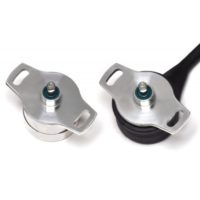The Positek P501 provides high accuracy rotary positioning in the tighest of spaces

The Positek P501 provides high accuracy rotary positioning in the tighest of spaces
The P501 is a miniature, affordable, durable, high-accuracy rotary sensor designed for industrial and scientific feedback applications, but requires a smaller footprint than the P500.
Like all Positek sensors, the P501 provides a linear output proportional with angle of deflection. Each unit is supplied with the output calibrated to the angle required by the customer, between 30 and 140 degrees. It is particularly suitable for OEMs seeking good sensor performance for arduous applications where space is important.
Overall performance, repeatability and stability are outstanding over a wide temperature range. The sensor has a rugged nickel plated aluminium body and integrated mounting flange. The flange has two 4.5mm by 20 degree wide slots on a 38mm pitch to simplify mounting and position adjustment. Sealing is to IP67 (boot version) and full EMC protection is built in.
Get a detailed view of our products, including their features, specifications, and available models. Find the perfect solution for your needs.

Our product offers a range of advanced features and benefits that set it apart from the competition. With cutting-edge technology and exceptional performance, it delivers unparalleled value to our customers.

Experience improved productivity and precision with our product’s state-of-the-art capabilities.

Simplify complex tasks and optimize workflow with our product’s intuitive design.

Count on our product for long-lasting reliability and consistent performance in any environment.
Find answers to common questions about our products and services.

The service provided by Everight was exceptional. They helped us find the perfect sensor for our application and their expertise was invaluable.


The service provided by Everight was exceptional. They helped us find the perfect sensor for our application and their expertise was invaluable.


The service provided by Everight was exceptional. They helped us find the perfect sensor for our application and their expertise was invaluable.

Fill out the form below to request more information
"*" indicates required fields
"*" indicates required fields